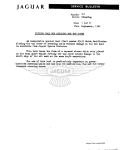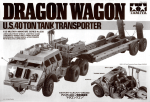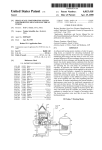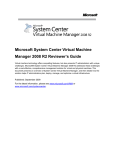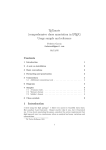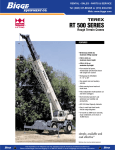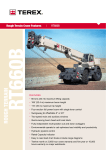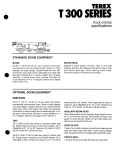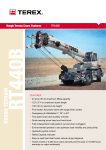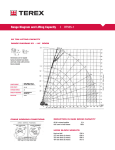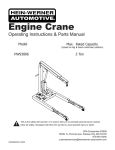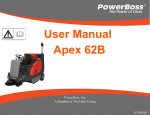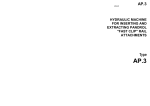Download HyDRAULIC EXCAVATOR SPM#9308128
Transcript
BULLETIN CED-26 Price $4.00 PRINTED IN U.S.A. •3013.1:a 'CORPORATION CONSTRUCTION EQUIPMENT DIVISION WAUKESHA, WISCONSIN 53187 BULLETIN CED-26 service manual HYDRAULIC EXCAVATORS model serial no. This manual contains operating instructions, service information, and repair parts lists for all models unless otherwise noted. Almost half a century of design and manufacturing experience has gone into your new Mein-Werner machine. It is the finest equipment that this know-how and modern technology can produce. We congratulate you on your selection. We recommend that you become familiar with this manual and the maintenance procedures outlined herein. Following these instructions and operating the machine in a proper manner will assure you of long, dependable and profitable service. cORPORATION CONSTRUCTION EQUIPMENT DIVISION WAUKESHA, WISCQNSIN 53187 INSTRUCTIONS FOR ORDERING REPLACEMENT PARTS To assure prompt and accurate service, include the following data with each parts order: 1. 2. 3. 4. 5. 6. 7. Model and Serial number of machine ' Part numbers Part descriptions Quantity of each part desired Correct shipping destination Method of transportation Engine Serial number Confirm all telephone and telegraph orders in writing. Be sure these orders are marked "Confirmation," to avoid duplication of orders. WHERE TO ORDER PARTS Hein-Werner Dealers are conveniently located throughout the United States and Canada. These Dealers maintain a stock of genuine HeinWerner replacement parts. Always order parts from your nearest Hein-Werner Dealer. INSPECTION OF SHIPMENTS Carefully inspect all shipments upon arrival. In the event of loss or damage, do not accept the shipment until the transportation company either makes a notation on the freight bill, or gives you an inspection report covering said damage or loss. In the event of concealed damage or loss, notify the carrier at once (within 20 days) requesting that an inspection be made and damage or loss be acknowledged. ADJUSTMENTS AND RETURNS Refer to the written Warranty in this manual for an explanation of Warranty policy. If you feel a Warranty claim is in order, consult your Dealer. Claims must be made through your Dealer within a 15 day period from the time a failure occurs. Parts returned directly to the factory, without Dealer Authorization, will not be accepted. USE ONLY GENUINE HEIN-WERNER PARTS FOR MAXIMUM PERFORMANCE ii TABLE OF CONTENTS Page SECTION I - DESCRIPTION 1-1. Hydraulic Circuits and Controls 1-2. Carrier 1-3. Accessories 1 1 4 4 SECTION II - OPERATION 2-1. Preparation for Use 2-2. Initial Checks 2-3. Starting the Engine 2-4. Operating Controls 2-5. Digging Hints 2-6. Stopping the Engine 2-7. Preparation for Storage 5 5 5 5 5 8 8 8 SECTION III - MAINTENANCE AND 'REPAIR . . 3-1. Preventive Maintenance 3-2. Lubricant Recommendations . . ............ . .. 3-3. Maintenance Schedules .... 3-4. Lubrication - Upperstructure . • 3-5., Lubrication - Crawler 3-6. Lubrication - Carrier 3-7. Propel Drive Chain Adjustment 3-8. Crawler Track Adjustment 3-9. Hydraulic Circuit Pressure Checks 3-10. Swing and Propel Brake Adjustment '3-11. Tool Kits 3-12. Gear Box Removal 3-13. Propel and Swing Gear Box Repair . . . 3-14. Shaft Bearing Adjustment 3-15. Gear Box Replacement 3-16. Hydraulic Cylinder Repair 3-17. Crawler Drive Sprocket Removal 3-18. Tumbler or Idler Shaft Bushing, Thrust Washer and Seal Replacement SECTION IV - REPAIR PARTS LIST 9 9 9 . 9 12 12 12 12 12 13 14 15 15 16 18 18 18 20 20 21 iii 1. 2. 3. 4. 5. 6. 7. 8. 9. Hydraulic Reservoir Return Lines Filters Hydraulic Swing Motor House Brake Drum Swing Gear Box Hydra-Swivel Ball Bearing Ring Gear Levers 10. Foot Pedals 11. Machinery Platform 12. Pressure Compensating Unit 13. Inline Pressure Compensating Unit 14. Swing System Control Valve 15. Boom, Bucket, and Propel or Outrigger Control Valve Figure 1. Machinery Platform iv 16. Dipstick and Propel or Outrigger Control Valve 17. Swing System, Pump System 18. Dipstick and Propel or Outrigger Pump Section 19. Boom, Bucket, and Propel or Outrigger Pump Section 20. Clutch 21. Engine SECTION I DESCRIPTION 1-1. HYDRAULIC CIRCUITS AND CONTROLS. The information in this section is designed to furnish the owner and operator of Hein-Werner excavators with the basic information needed to understand the operation of the machine. An understanding of the various systems is essential to proper operation and service, and we suggest this description be read thoroughly. Power for the unit is supplied by either a gasoline or diesel engine (21, Figure 1) the make of which is optional. (For service parts and information, refer to the engine manual supplied with your machine.) The engine is coupled to the hydraulic pump by either a direct drive shaft or a clutch (20). The clutch is extremely useful as a starting aid in cold weather. (If your machine is equipped with a clutch, refer to the separate section included with this manual. The pump is a gear type, with three sections in tandem, mounted directly to the engine clutch housing. Each pump section is fitted with a separate supply line from the reservoir to assure proper oil flow. The pump section (19) closest to the engine delivers power to the boom, bucket, and propel control valve (15) on the crawler mounted machine, and to the boom, bucket, and outrigger system on the carrier mounted machine. The center pump section (18) supplies power to the dipstick and propel circuit valve (16) on the crawler mounted machine and to the dipstick and outrigger system on the carrier mounted machine. The pump section (17) furthest from the engine delivers power to operate the swing circuit on all models. The three pump sections are completely independent of each other enabling simultaneous use of all three circuits. The oil flows from the pump to the three control valves. When the control valves are in a neutral position, the oil flows without restriction through the control valve and return lines (2) to the filters (3) which are mounted on the hydraulic reservoir (1). Each circuit is equipped with a filter which contains a cleanable filtering element. Disposable elements also are available as a replacement part. After being filtered, the oil flows directly into the reservoir. The control valves are operated by levers (9) and foot pedals (10) in the operator's cab. The cab is also equipped with a complete set of engine gages and controls. The engine gage set consists of an ammeter, individual gages for fuel level, oil pressure and water temperature, and a combination tachometer and engine revolution hour meter. When a typical cylinder circuit is put into operation by moving the control lever or foot pedal in either direction from the neutral position, the valve spool moves within the control valve. This spool reroutes the oil flow from the return line port to the port which supplies oil to the cylinder being used. This spool is spring-loaded to return to neutral position when the control lever or pedal is released. The control valves have excellent "feathering" characteristics to assure smooth and precise operation of all components. The control valves contain a relief valve which is adjusted at the factory to a specified limit. If the pressure demanded by the circuit being used exceeds this pre-set limit, the relief valve will bypass the oil to the reservoir until the pressure demanded by the circuit drops to the specified pressure setting. The digging members are also protected from overload by an inline pressure compensating unit (13). This unit relieves the pressure in the boom and dipstick circuits when external forces cause the pressure to exceed the maximum allowable. The swing circuit is controlled by the single spool control valve (14). This valve and its built-in relief valve are identical in design and purpose to the typical cylinder control valve already described. The swing circuit is also further protected by a pressure compensating unit (12) which minimizes shock loads. The double rotation, positive displacement hydraulic motor (4) provides unlimited swing in either direction. The motor is directly coupled to the swing gear box (6) which is mounted to the machinery platform (11) with specially ground alloy steel studs. This mounting assures perfect mesh between the output pinion and the ball bearing ring gear at all times. All gears and shafts in the swing system are precision machined and hardened to give maximum life. The shafts are carried by tapered roller bearings. The cover and case are precision bored and milled to assure precise gear mesh. The use of a double row ball bearing ring gear (8) results in reduced maintenance, smoother rotation, and longer life. The bearing requires no day-to-day maintenance other than lubrication. The crawler propel control valve is essentially the same as the other control valves except for an added "detent" feature. This "detent" mechanism holds the valve spool in either position to allow the operator to perform other operations while traveling. The control levers must be manually returned to the neutral position to stop the crawler travel. When the propel circuit is in operation, the oil flows from the control valve, through the hydraswivel (7) to the propel motors. The hydra-swivel is used on both the carrier and the crawler mounted machines. Its purpose is to allow oil to flow from the upper structure to the propel motor or the outrigger cylinders which are located on the nonrotating portion on the machine. This is accomplished 1 RESERVOIR 0 BOOM CYLINDER L. H INLINE RELIEF SW ING I A\■ F? 0\1 BOX HYDRA-SWIVEL • Ai DIPSTICK CYLINDER BUCKET CYLINDER L wzr , 11 Ail Are/ CLUTCH i ii PUMP ' 0 0 HPRESSURE COMPENSATING UNIT BOOM CYLINDER R. H. P1V—rj lir • - BOOM BUCKET AND PROPEL OR. OUTRIGGER VALVE DIPSTICK INLINE AND PROPEL OR RELIEF OUTRIGGER VALVE SWING VALVE Figure 2. Upper Circuitry PRESSURE COMPENSATING UNIT PROPEL MOTOR FRONT OF MACHINE HYDRA SWIVEL ASSEMBLY FORWARD TRAVEL PRESSURE HOSES DRAIN HOSE PRESSURE COMPENSATING UNIT Figure 3. Lower Circuitry, Crawler u. PROPEL MOTOR HYDRA-SWIVEL ASSEMBLY OUTRIGGER CYLINDER OUTRIGGER CYLINDER LOOKING TOWARD FRONT OF CARRIER Figure 4. Lower Circuitry, Carrier by the use of a series of ported grooves which are sealed with "0" rings. The two propel motors are mounted directly to the propel gear boxes. Each track of the crawler is driven by a separate motor and gear box. This independent drive results in greatly increased maneuverability. 1-2. CARRIER The standard Hein-Werner Carrier is of rugged job-proven design. The carrier can be equipped with a remote control unit which enables the operator to steer, shift, brake, and accelerate the carrier from within the excavator cab. 1-3. ACCESSORIES The crawler track assemblies and carbody are designed for long trouble-free service. The carbody and side frames are rugged, steel fabrications which are reinforced at all points of stress concentration. The components of the track assemblies such as the track shoes, tumblers, idlers, rollers, and sprockets, are made from high grade heat treated alloy steel with excellent durability characteristics. These parts are designed to provide good dirt shedding qualities. The 20 track rollers are equipped with pre-greased ball bearings with armor shields to protect the seal from dirt, branches, and other foreign matter. The use of these bearings also results in reduced dayto-day maintenances of the track assembly. 4 Accessories include a log grapple, a clam shell bucket, frost point, and a special 60" ditch cleaning bucket. Various standard buckets are also available. These buckets range in size from 16" to 48" widths. If your machine is equipped with any of the above mentioned accessories, refer to the special section in this manual for service and parts information. The following basic schematics will be useful in tracing the hydraulic circuitry: 1. Upper circuitry (Figure 2). 2. Lower circuitry, crawler (Figure 3). 3. Lower circuitry, carrier (Figure 4). SECTION II OPERATION 2-1. PREPARATION FOR USE. Before operating the machine, make the following checks and adjustments: ALL MODELS 1. Engine checks (see engine manual for detailed instructions). a. Crankcase oil level. b. Fan belt tension. c. Coolant level. d. Air cleaner. b. Block up the machine and release pressure on the boom. c. Remove the four locking bolts. Attach a chain to the side frame and the bucket. Use the bucket to pull the tracks out until the side frame is flush with the cross tube. d. Replace and tighten the locking bolts in the second set of holes. Extend the opposite track in a similar manner. Each track will move out four inches to give 104 inch overall width. 2-2. INITIAL CHECKS. SWING BEARING e. Level of electrolyte in battery. f. Battery and terminals for corrosion. g. Tightness of mounting bolts. h. Fuel level. 2. Upperstructure checks. a. Security of fuel, oil, and electrical connections. b. Freedom of operation of all controls. c. Oil level in hydraulic reservoir. Remove the high level plug and check that the oil level is between the high level plug and the low level plug. If necessary, add premium grade SAE 20 oil. d. Damage which may have occurred in shipment. e. Level of lubricant in gear boxes. If necessary, add EP 80-90 oil. f. Lubricate entire machine as required; see paragraphs 3-4,3-5, and 3-6. After six to eight hours of running time, check the swing bearing mounting bolts for tightness. Torque the bolts to 2400 inch pounds. CYLINDERS After four to eight hours of initial operation, tighten the hydraulic cylinder packing nuts to prevent excessive escape of hydraulic oil around the cylinder rods. Tighten the nuts until they are snug and then back them off 1/4 to 1/2 turn. Do not overtighten; a small seepage of oil at these points is necessary for cylinder rod lubri?ation. 2-3. STARTING THE ENGINE. Leave all control levers in neutral. Place throttle in approximately half-fuel position. Place ON-OFF switch in ON position or place fuel shut-off lever in RUN position. Depress starter button to crank engine. If engine fails to start after two or three attempts, refer to engine manual for cause of trouble and instructions to correct it. 2-4. OPERATING CONTROLS (See Figure 6). CRAWLER MODELS 1. Carbody and side frame assembly checks. a. Tightness of all mounting bolts, see Table 4. b. Track adjustment, see paragraph 3-8. c. Drive chain adjustment, see paragraph 3-7. 2. When the crawler-mounted machines are shipped from the factory, they are assembled to the legal 96-inch shipping width. They may be operated at this width or extended to 104 inch width for greater stability. To extend the tracks, proceed as follows: a. Swing the boom (see Figure 5) over the side of the tracks and with the bucket tucked, apply down pressure with the boom to lift the track off the ground. Operators not familiar with hydraulic machines may tend to over-control and thereby cause rough operation of the machine. It is recommended that the machine be operated at half throttle or less until the operator gets the "feel" of the controls. The throttle setting may then be gradually increased to fully governed speed. The operation of each control is as follows: BOOM CONTROL LEVER 1. To raise boom, pull boom control lever back. 2. To hold boom in position, move control lever to center position (neutral). 3. To lower boom, push boom control lever forward. Figure 5. Extending Crawler Tracks BUCKET CONTROL PEDAL OR LEVER 1. For normal operation, use the foot pedal to control the bucket. However, for very close work when speed is not a factor, use the lever to control critical movement of bucket. 4. To open dipstick, push down with toe of the right foot on the pedal or push the control lever forward. SWING CONTROL LEVER 2. To place bucket in closed position, push down with heel of left foot on the pedal or pull the lever back. 1. To swing platform in a clockwise direction, push lever forward. 3. To hold bucket in position, move the pedal or lever to center position (neutral). 2. To swing platform counterclockwise, pull lever back. 4. To place bucket in open position, push down with toe of left foot on the pedal or push the lever forward. The swing of the platform is controlled by reversing the control lever. Slight overcontrol allows the machine to be operated with a high degree of smoothness with no abrupt or dead stops. For example, if the machine is rotating clockwise (lever pushed forward), feather the lever back toward the operator until the rotation stops. If one particular position is desired, lock the platform in place with the swing brake control lever. DIPSTICK PEDAL OR LEVER 1. For normal operation, use the foot pedal to control the dipstick. However, for very close work when speed is not a factor, use the lever to control critical movement of dipstick. SWING BRAKE OR PROPEL BRAKE LEVER 2. To tuck dipstick in, push down with heel of right foot on the pedal or pull the lever back. 3. To hold dipstick in place, move the pedal or lever to center position (neutral). 6 1. To engage brake, pull up on the lever. The lever will snap into an overcenter loch position. 2. To release brake, push the lever down. PROPEL OR OUTRIGGER CONTROL LEVERS PROPEL LEVERS When in the normal traveling position (drive sprockets to the rear), follow the instructions below. When in reversed position (drive sprockets to the front), reverse all directional instructions. The speed of travel is governed by the engine speed. 1. To propel machine forward, push both levers forward. 2. To propel machine backward, pull both levers back. 3. To make a right hand turn, use any of the following procedures: a. Push the left lever forward and leave the right lever in neutral. b. Pull the right lever back and leave the left lever in neutral. c. When working in close quarters, or when speed is required, a right hand "spin" turn may be made by simultaneously pushing the left hand lever forward, and the right hand lever back. 4. To make a left hand turn, reverse the above directions. OUTRIGGER LEVERS 1. To set outriggers, push both levers forward. 2. To raise outriggers, pull both levers back. When in the digging position (boom extended over the rear of the carrier), the left outrigger is controlled by the left lever. STARTER BUTTON BOOM CONTROL LEVER INSTRUMENT PANEL DIPSTICK CONTROL LEVER CHOKE LEVER THROTTLE LEVER EMERGENCY STOP KNOB PROPEL CONTROL LEVERS (CRAWLER) SWING CONTROL. LEVER BUCKET CONTROL LEVER PROPEL BRAKE CONTROL LEVER (CRAWLER) OUTRIGGER CONTROL LEVERS (TRUCK) HEIGHT ADJUSTMENT SWING BRAKE CONTROL LEVER DIPSTICK CONTROL PEDAL BUCKET CONTROL PEDAL Figure 6. Operating Controls SEAT ADJUSTMENT CONTROLS The seat height can be adjusted by pulling out the height adjustment pin, setting the seat to the desired height and then reinserting the pin. The seat can be moved forward and backward by pulling out the pin under the seat, sliding the seat cushion to the desired position and then reinserting the pin. 2-5. DIGGING HINTS. 1. Keep the machine as close to the work as possible. This results in a greater mechanical advantage and also cuts down the cycle time. Start a cut with the dipstick at right angles to the boom point; this will decrease cycle time because the boom does not have to be repositioned as often. 2. Tuck in the dipstick as the boom is raised out of a cut; this will permit clearing the top of the cut sooner and reduce the cycle time. Square cuts for manholes, etc., can be made easier by moving the machine in line with each bank, rather than using the swing to get from bank to bank. 3. Make straight down end cuts by extending the dipstick and bucket and moving the machine forward or back to reach the bottom of the cut. To decrease cycle time, especially in a deep cut, shave off a layer at a time, rather than going to the bottom of the cut on every cycle. Rocks and stumps can be uncovered, undermined, and pried out using the bucket. 4. For faster dumping, open both the bucket and the dipstick. When digging in gravel, stones, or shale, use the bucket teeth to loosen the material so that the bucket can be filled on the next cycle. When digging in clay or hard soil, use the bucket in a flat position and shave or peel the soil by moving the boom and dipstick. The bucket can be removed and reattached in an inverted position to use the machine for shovel operation. 2-6. STOPPING THE ENGINE. gency, stop knob located on back wall of cab. This will shut off the air supply to the engine by tripping the air shut-off valve. If air shut-off valve has been tripped, it must be reset before the engine will operate. To reset the air shut-off valve, first push the emergency stop knob all the way in, and then manually reset the air shut-off valve latch. Refer to the engine manual for detailed instructions. 2-7. PREPARATION FOR STORAGE. If the machine is to be stored for an indefinite length of time, perform the following procedures, subject to the length of the anticipated storage period: 1. Drain fuel system and refill with Valvoline Oil Company "Tectyl 503-C" rust preventative compound or its equivalent. 2. Drain engine lubricant and refill with engine preservative oil. 3. Drain engine cooling system and refill with corrosion inhibitor. 4. Crank engine to circulate preservative oils through fuel and lubricating systems. 5. Drain lubricant from swing and propel gear boxes and refill with preservative oil. Wherever fluid systems have been drained, attach a waterproof tag to the tank or engine, to warn the operator not to operate the machine until the system(s) have been drained and refilled with correct fluid. 6. Remove battery. 7. Relieve engine belt tension. Tag the belts to indicate that belt tension must be adjusted before starting engine. 1. Reduce engine speed to idle. Allow engine to operate at idle speed for approximately five minutes to normalize engine temperature, then place the ON-OFF switch or fuel shut off lever in OFF position. Do not stop the engine suddenly unless it is absolutely necessary. 8. Wipe machine to remove all film and dirt. Apply preservative to any exposed metal surfaces subject to corrosion through prolonged non-usage, such as valve spools, cylinder rods, etc. 2. If the engine continues to run after the fuel shut-off lever is placed in OFF position, pull emer- 10. Fill hydraulic system completely with hydraulic oil. 9. Close and secure all doors. Seal all openings with waterproof paper. SECTION III MAINTENANCE AND REPAIR 3-1. PREVENTIVE MAINTENANCE. 3-2. LUBRICANT RECOMMENDATIONS. It is impossible to overstress the importance of preventive maintenance. A well organized, day-to-day preventive maintenance schedule will save you expensive "downtime" and costly repairs. In addition it will help to insure proper operation and extended life of the machine. To insure maximum efficiency and long life, use the lubricants recommended in Table 1 or their equivalent. This section outlines suggested maintenance schedules, lubrication guides, and minor adjustments which should be made to maintain optimum performance from your machine. These schedules, and the preventive maintenance record sheets included with this manual, will help you organize a good system of daily care which best suits your particular operation. The maintenance requirements listed are for average working conditions. If your machine is subject to adverse conditions, such as extreme dust, moisture, etc., the frequency and extent of the maintenance precedures should be increased accordingly. A one year supply of "Preventive Maintenance Record" forms is included at the end of this manual. A sample copy, with several typical entries made, has also been included to show how these records may be maintained. These records, when kept complete and up-to-date, will benefit both the owner and the operator. 3-3. MAINTENANCE SCHEDULES. Follow the maintenance schedules and procedures as outlined in Tables 2 and 3. Table 1. Recommended Lubricants Part Lubricant Gear Boxes EP 80-90 oil Open Gears Crater compound Swing bearing (4 fittings) Mobilux GR #2 or equivalent. Gear box bearing grease fittings Mobil No. 5 grease, or equivalent. All other grease fittings Moly type grease, such as Mobiloil special or equivalent. Hydraulic reservoir Premium grade SAE 20 oil. Table 2. Preventive Maintenance and Inspection Schedule (Upperstructure - All Models) Frequency Service or Inspection to be Performed Daily Lubricate as required. See paragraph 3-4. Daily Inspect for and correct any fuel, oil, coolant, or hydraulic system leaks. Daily Check oil level in swing gear box. If necessary, add oil as specified in Table 1. Daily Check oil in hydraulic reservoir. If necessary, add oil as specified in Table 1. Daily Check back pressure indication of filter gages. If gage registers in "red zone," clean or replace filter element. Daily Check engine for: crankcase oil level, coolant level, engine belt tension; and level of electrolyte in battery(s). (See engine manual for complete specifications.) Weekly Check swing bearing mounting bolt torque; tighten to 2400 inch pounds if necessary. Table 2. Preventive Maintenance and Inspection Schedule (Cont) (Upperstructure - All Models) Frequency Service or Inspection to be Performed Monthly Check hydraulic system pressures. See paragraph 3-9 for detailed instructions. Monthly Check swing brake adjustment. See paragraph 3-10. Monthly Check all mechanical linkage connections. Monthly Check all mounting and assembly bolts. Tighten if necessary. Refer to Table 4. Monthly Check all hydraulic system hoses, lines, and fittings for signs of possible trouble. As Inspect bucket teeth and replace as necessary. Do not use shanks without teeth for digging. required As required Remove filter screen from hydraulic reservoir. Clean screen thoroughly with cleaning solvent. Be sure filter screen is in place when adding oil. DIPSTICK CYLINDER BASE PIN DIPSTICK CYLINDER ROD PIN BOOM LIFT PIN BOOM CYLINDERS ROD END :-.7 7- 77 7:71 _ - -1-. I BUCKET CYLINDER BASE PIN I 11 11 11 II 11 11 I, I I ■ ........ I I I I I I I BOOM PIVOT PIN III I I 121, ip" ........1 -- '''l DIPSTICK PIVOT PIN .... --- --•-- -1 BOOM CYLINDERS BASE END 1I 'II...L.-a, —— — 1 : r - r ‘......._-,...-, Jo, 111---11:2--1::;:zrj-:"1 4 ---,..:—..1. ----IC . —._._I1_-1111i ii: 0I' BELL CRANK PIVOT PIN BUCKET PIVOT PIN BUCKET LINK BUCKET LINK AND BUCKET CYLINDER ROD END Figure 7. Lubrication Diagram — Sheet 1 , , i *4w'1 Phi --r . . ,/i,Ili Table 3. Preventive Maintenance and Inspection Schedule - Crawler Frequency Service or Inspection to be Performed Daily Check level of lubricant in propel box. See paragraph 3-15. Daily Lubricate as required. See paragraph 3-5. Weekly Check propel drive chain adjustment. See paragraph 3-7. Weekly Check crawler track adjustment. See paragraph 3-8. Monthly Check propel brake adjustment. See paragraph 3-10. Monthly Check all mounting and assembly bolts. Tighten if necessary. Refer to Table 4. Monthly Check all mechanical linkage connections. Monthly Check all hydraulic system hoses, lines, possible trouble. and fittings for signs of PUMP DRIVE BEAR ING INTERMEDIATE SHAFT OUTPUT SHAFT SWING CLUTCH GEAR CONTROL LEVER F ITTINGS (4) • mCiPi'i..;:gv...T.1*'..W•gi:;1.,:17..,3:•:1015•4•Vr•W•1',. 34!::,.:F47... CROSS SHAFT CONTROL LEVER FITTINGS (2) Figure 8. Lubrication Diagram — Upperstructure, Sheet 2 . 11 PROPEL GEAR BOX FITTINGS SWING BEARING FITTINGS (4) RH IDLER SHAFT FITTINGS (2) RH TUMBLER SHAFT FITTINGS (2) LH IDLER SHAFT FITTINGS (2) LH TUMBLER SHAFT FITTINGS (2) Figure 9. Lubrication Diagram — Crawler 3-4. LUBRICATION - UPPERSTRUCTURE. Lubricate the upperstructure at the points shown in Figures 7 and 8. Always remove excess grease after lubrication, or dirt and dust will accumulate and work into bearings and bushings. 2. Loosen the four adjusting bolt lock nuts and tighten both adjusting bolts equally to adjust chain until deflection is 3/4" to 1". 3. Tighten lock nuts and gear box mounting bolts and recheck deflection. 3-5. LUBRICATION - CRAWLER. 3-8. CRAWLER TRACK ADJUSTMENT. Lubricate the crawler assembly at the points specified in Figure 9. Be sure to lubricate crawler daily, even though the machine has not been traveling, since there is movement when swinging and digging. DO NOT lubricate propel drive chain. The crawler tracks should be adjusted until some slack exists. When there is no slack, or excessive slack, adjust the tracks at the idler end of the side frame (Figure 12) as follows: 3-6. LUBRICATION - CARRIER AND OUTRIGGERS. 1. Remove shim cover plate. 2. Insert Hein-Werner Pushmaster unit, supplied with tool :kit, as shown. Lubricate carrier as specified in the carrier manual shipped with your machine. Lubricate the outriggers at the points indicated in Figure 10. 3. Turn the relief knob clockwise, and "jack" out the idler bearing block until correct slack exists. 3-7. PROPEL DRIVE CHAIN ADJUSTMENT. 5. Release the pressure on the Pushmaster Unit by turning relief valve knob counterclockwise. Check propel drive chain for 3/4" to 1" deflection on the slack side of chain. If necessary to adjust, proceed as follows: 1. Loosen the four propel box mounting bolts (Figure 11) which attach gear box to side frame. 12 4. Install the 1/4" and 1/8" thick shims (furnished in the tool kit) as required to take up play. 6. Replace the shim cover plate. This adjustment must be performed on both the inside and the outside of the side frame. The two idler bearing blocks must be adjusted equally to keep the idler from becoming "cocked." 1. Outrigger Cylinder Rod Pin 2. Outrigger Foot Pivot Pin 3. Outrigger Arm Pivot Pin 7 4. Outrigger Cylinder Base Pin 5. Outrigger Arm Pivot Pin 6. Outrigger Cylinder Rod Pin Outrigger Foot Pivot Pin Figure 10. Lubrication Diagram — Outriggers 3-9. HYDRAULIC CIRCUIT PRESSURE CHECK. The correct control valve and pressure compensating unit adjustments have been made before shipping from the factory. Only factory and dealer representatives are authorized to adjust valve pressure settings. TAMPERING WITH PRESSURE SETTINGS WILL RESULT IN VOIDING THE WARRANTY OF THE MACHINE. However, at the intervals specified in the maintenance schedule, or in the event of malfunction, check the pressure settings as follows: NOTE Be sure gage is indicating correctly before proceeding. 1. BOOM CIRCUIT PRESSURE CHECK. Install 0-3000 psi pressure gage in boom cylinder testing port as shown in Figure 13. Run engine at full throttle and pressurize boom cylinder rod end by pushing boom control lever forward. Boom cylinder pressure gage should indicate 1850 to 1900 psi. 2. BUCKET CIRCUIT PRESSURE CHECK. Install 0-3000 psi pressure gage in bucket cylinder testing port as shown in Figure 14. Run engine at full throttle and pressurize bucket cylinder rod end by pushing bucket control lever forward. Bucket cylinder pressure gage should indicate 2050 to 2100 psi. 3. DIPSTICK CIRCUIT PRESSURE CHECK. Install 0-3000 psi pressure gage in dipstick cylinder testing port as shown in Figure 15 at base end of the cylinder. Run engine at full throttle and pressurize dipstick cylinder rod by pulling dipstick control lever back. Dipstick cylinder pressure gage should indicate 2050-2100 psi. 4. PROPEL CIRCUIT PRESSURE CHECK. Place machine so that forward and backward travel are 13 MOUNTING BOLTS (4) PUSHMASTER UNIT 1 ADJUSTING BOLTS Figure 12. Crawler Track Adjustment ADJUSTING BOLTS LOCK NUTS (4) Figure 11. Propel Drive Chain Adjustment completely blocked. Install 0-3000 psi pressure gage in each propel crossover valve as shown in Figure 16. With engine at full throttle, push both propel control levers forward. The gages should indicate 2050-2100 psi. If the gages do indicate no pressure reading, repeat same procedure except pull both levers back. The two gages should read 2050 to 2100 psi. Figure 13. Pressure Gage Installed in Boom Cylinder Testing Port 14 5. SWING CIRCUIT PRESSURE CHECK. Place unit so that swing is completely blocked in both directions. Install 0-3000 psi pressure gages in pressure compensating unit counterclockwise and clockwise swing testing ports as shown in Figure 1'7. Run engine at full throttle and pressurize swing circuit for clockwise swing by pushing swing control lever forward. Pressure gage in clockwise swing testing port should indicate 1650 to 1700 psi. Run engine at full throttle and pressurize swing circuit for counterclockwise swing by pulling swing control lever back. Pressure gage in counterclockwise swing testing port should indicate 1650 to 1700 psi. 3-10. SWING AND PROPEL BRAKE ADJUSTMENT. The swing brake is common to all models. Crawler mounted machines, in addition, are equipped with a Figure 14. Pressure Gage Installed in Bucket Cylinder Testing Port Figure 15. Pressure Gage Installed in Dipstick Cylinder Testing Port Figure 16. Pressure Gage Installed in Propel Circuit Cross-over Relief Valve brake on each propel gear box. The adjusting procedures are identical for both propel and swing brake assemblies. The brakes can be adjusted at three points: 1. In the handle itself. 2. At either end of the conduit. 3. At the gear box connection. The swing, and propel, brake is a static brake only. Therefore, the amount of wear should be very small. However, if the brakes do need adjusting, proceed as follows: and block the machine as described in paragraph 2-1 and Figure 5. Disconnect the hydraulic lines from the propel motor, remove the brake cable and mounting bracket from the gear box. Disconnect the four locking bolts which attach the side frame to the carbody cross tubes. Attach chain as shown in Figure 5 and pull the entire side frame off. The side frame assembly can now be tipped flat to facilitate the removal of the drive chain and gear box. The swing gear box is easily removed by unscrewing the four retaining nuts and lifting off the gear box. 1. Make the initial adjustment in the handle itself, by turning the knurled adjusting .knob at the tip of the handle until the handle "snaps" into an overcenter lock position when pulled up. 2. If for some reason the adjustment can not sufficiently be made in the handle, make the remaining adjustment at either of the other two points. 3-11. TOOL KITS. The tool kit for the carrier mounted machines (Figure 18) includes the tools necessary for all maintenance and adjustments of the upperstructure. The tool kit supplied with crawler mounted machines (Figure 19) includes the tools for the upperstructure plus the extra tools necessary for adjustments and maintenance of the crawler. This kit also includes shims and groove pins for the crawler tracks. 3-12. GEAR BOX REMOVAL. To remove the propel gear box, swing the boom over the side frame which is to be removed. Disconnect the safety chain from the carbody. Raise Figure 17. Pressure. Gage Installed in Swing Circuit Pressure Compensating Unit Testing Port 15 1. Grease Gun 2. Spanner Wrench - Cylinder Heads 3. Open End Wrench, 7/8" and 1" 4. Open End Wrench, 1-1/4" 5. Universal Joint, 3/4" Drive 6 Socket, 1-1/16", Deep Throat 3/4" Drive 7. Socket, 1-1/8", Deep Throat 3/4" Drive 8. Socket, 15/16", Standard 3/4" Drive 9. Extension, 12", 3/4" Drive 10. 11. 12. 13. 14. 15. 16. 17. 18. Crescent Wrench, 15" Special Tube Wrench, 1-1/2" Sliding "T" Handle, 3/4" Drive Open End Wrench, 3/8" Drain Valve Handle - Oil Reservoir Plugs, 1-1/4" - Supply Lines (2) Plug, 1" - Supply Lines Tool Box Tee Handle - Machinery Housing Doors Figure 18. Tool Kit — Carrier Mounted Machine 3-13. PROPEL AND SWING GEAR BOX REPAIR. The gear boxes are of relatively simple construction and therefore detailed disassembly and repair instructions are not necessary. However, for ease of disassembly and repair, and also to guard against unnecessary damage to the gear box components, we recommend that the following list of general hints and precautions be followed: 16 1. Use a soft hammer when assembling or disassembling any parts which may become nicked or marred. NOTE 2. Use a press wherever possible to remove and replace gears and bearings. 3. Use care when removing seals and bearing cups to avoid damaging the case, or cover, in which the components are seated. 4. Replace hex nuts and bolts with rounded corners, all lockwashers, oil seals and gaskets. Use only genuine Hein-Werner parts to insure proper fit and operation. 5. Clean the threads of all bolts, studs, and nuts to assure proper torque and adjustment. Upperstructure Tools 1. 2. 3. 4. 5. 6. 7. 8. 9. Grease Gun Spanner Wrench - Cylinder Heads Open End Wrench, 7/8" and 1" Open End Wrench, 1-1/4" Universal Joint, 3/4" Drive Socket, 1-1/16", Deep Throat 3/4" Drive Socket, 1-1/8", Deep Throat 3/4" Drive Socket, 15/16", Standard 3/4" Drive Extension, 12", 3/4" Drive 10. 11. 12. 13. 14. 15. 16. 17. 18. Crescent Wrench, 15" Tube Wrench, 1-1/2" Special Sliding "T" Handle, 3/4" Drive Open End Wrench, 3/8" Drain Valve Handle - Oil Reservoir Plugs, 1-1/4" - Supply Lines (3) Plug, 1" - Supply Lines Tool Box Tee Handle - Machinery Housing Doors Crawler Tools Cl. Hein-Werner Pushmaster Unit - Track Adjustment C2. Chain Adapter - Sprocket Removal C3. Track Adjusting Shims, 1/4" (16) C4. Track Adjusting Shims, 1/8" (20) C5. Socket, 1-5/16", Standard 3/4" Drive C6. Track Shoe Groove Pins (6) Figure 19. Tool Kit — Crawler Mounted Machine 17 6. Carefully clean and inspect all parts for signs of wear or future failure. Table 4. Torque Values Description Torque 3-14. SHAFT BEARING ADJUSTMENT. The intermediate shaft bearings are adjusted by means of shims under the shaft cover. Use shims as required to obtain .002 inch end play, to .002 inch preload on the bearing. The output shaft bearings are adjusted by positioning the nut on the upper end of the shaft. Tighten and secure nut as required to obtain .002 inch end play to .002 inch bearing preload. Pack the grease cavity of the shaft covers with Mobil #5 grease or equivalent. 3-15. GEAR BOX REPLACEMENT. No adjustment is necessary when replacing the swing gear box. When the gear box is in position on the mounting studs, the output pinion is in correct mesh with the swing bearing. Install the propel box and adjust the drive chain (see paragraph 3-7) while the side frame is removed. Tip the side frame back to the normal position by inserting the bucket teeth below the track shoes and tucking the bucket. Replace the side frame on the carbody cross tube by inserting a large pipe or timber between the bucket and the side frame and, using the dipstick, carefully push the side frames back in position. Replace the four locking bolts which hold the side frame to the carbody cross tubes. Connect the safety chain, brake cable and bracket, and the hydraulic lines. Gear Box intermediate shaft cover bolts 106 - 113 ft. lbs. Gear Box output shaft cover bolts 69 - 73 ft. lbs. Gear Box cover to case bolts 106 - 113 ft. lbs. Swing bearing to bearing adapter and platform bolts 200 ft. lbs. Swing bearing adapter to carbody bolts 300 ft. lbs. Carbody to cross tube bolts 556 ft. lbs. 3-16. HYDRAULIC CYLINDER REPAIR. Cylinder repair kits contain ram head and cylinder rod 0-rings, rod packings and wiper, piston rings and rod nut. Use all parts of the repair kit when a cylinder is repaired, even though some of the parts being replaced may not appear to be worn. It is not necessary to remove a cylinder assembly from the unit in order to repair it with a cylinder repair kit, but be extremely careful to prevent the entry of any dirt or foreign particles into the cylinder. Proceed as follows to service a cylinder: NOTE To refill propel gear box, remove the top filler plug and fill the gear box with EP 80-90 oil until the oil begins to run out the upper level checking plug located at the side of the gear box. Replace the plugs and check the gear box for oil leaks. Use only factory approved parts to insure proper fit and operation. 1. Use the spanner wrench supplied in the tool kit to remove the cylinder ram head. CYLINDER TUBE ASSEMBLY ROD NUT ROD 0 CYLINDER ROD HEAD 0 RING PISTON RINGS PISTON WIPER SEAL ROD PACKING SET Figure 20. Hydraulic Cylinder Disassembly 18 cylinder until the cylinder is completely filled with oil. 9. After 4 to 8 hours of operation with a cylinder which has been repacked, tighten the cylinder packing nut to prevent excessive escape of hydraulic oil around the cylinder rods. Do not overtighten as a small seepage of oil at this point is necessary for cylinder rod lubrication. The packing nut should be tightened snug, and then backed off 1/4 to 1/2 turn for the proper setting. 3-17. CRAWLER DRIVE SPROCKET REMOVAL. Use the Pushmaster Unit supplied with the crawler tool kit to remove the crawler drive sprocket. Attach a chain to the sprocket as shown in Figure 21. Replace the standard Pushmaster head with the 90 ° concave head adapter. Remove the shaft end plate. Install the Pushmaster as shown and pull the sprocket out until the drive chain will clear the track shoes. The drive chain can now be removed and the sprocket pulled completely off. Figure 21. Removing the Crawler Drive Sprocket SHAFT END PLATE 2. Pivot the cylinder to allow clearance for removing the cylinder rod and piston assembly. SIDE FRAME END PLATE 3. Remove hoses from base end of cylinder to release any suction. Remove rod assembly from cylinder tubes. 4. Disassemble the cylinder rod and piston assembly as indicated in Figure 20. Replace packings, piston rings, 0-rings, wiper seal, and rod nut. Lubricate all parts with hydraulic oil. Reassemble the cylinder rod and piston assembly. TRACK SHOE PIN • BEARING BLOCK 5. Replace the cylinder rod and piston assembly in the cylinder and screw the ram head into the end of the cylinder until it is tight. Replace hoses. DRIVE LOCK PIN 6. Slowly pivot the cylinder into position. Use control lever to apply slight hydraulic pressure to align the rod end with the cylinder rod end pivot point. 7. Insert the pivot pin. Lock the pivot pin in place. 8. Use the control levers to slowly apply hydraulic pressure alternately to both ends of the repaired Figure 22. Removing Idler or Tumbler Bearing Blocks 19 3-18. TUMBLER OR IDLER SHAFT BUSHING, THRUST WASHER, AND SEAL REPLACEMENT. To replace the shaft bushings, thrust washers, and seals, loosen the track by removing all adjusting shims. (See paragraph 3-8.) To remove either the idler or tumbler bearing blocks, remove track shoe pin (Figure 22) by driving out first the drive lock pin shown and then the track shoe pin from the opposite side. If the tumbler is to be removed, the drive chain must also be disconnected. Remove the side frame end plate and then the tumbler or idler and shaft assembly. Next remove the shaft, the shaft end plate, and the bearing blocks. When replacing bushings and seals, press the bushings in and install the seal in a reverse position (Figure 23) to allow the bushing to be "flushed" of dirt when being greased. Reassemble the thrust washers and bearingblocks to the shaft. (See Figures 41 and 42). To adjust the shaft end plate clearance, bolt one end plate tight. Add shims as required to obtain .020-.030 inch total clearance between the bearing block and the shaft end plate. When shimming the tumbler end, place the shims on the drive sprocket end of the shaft. Adjust the idler at either end of the shaft. Replace the shaft and tumbler or idler assembly in the side frame by reversing the disassembly procedure. Adjust the track as instructed in paragraph 3-8. 20 BEARING BLOCK Figure 23. Replacing Bushings and Seals WHEN ORDERING PARTS FOLLOW THE INSTRUCTIONS OUTLINED ON PAGE ii SECTION IV REPAIR PARTS LIST When ordering parts, always give the model number, machine serial number, and engine serial number as shown on the Serial Number Plate (Figure 24). All part numbers preceded by an asterisk (*) in the following lists are dealer-serviced assemblies. Contact your dealer for information concerning these parts. When ordering parts for engine drive packages, engine mounting packages, or any other assemblies for which part numbers are not listed, include the name of the part and the make of the engine in addition to the above information. • • /ffeaf'nePropt/ CONSTRUCTION EQUIPMENT SER. NO. MODEL NO. LOT NO. ENGINE NO. REFER TO MANUAL FOR LUBRICATION AND OPERATING INSTRUCTIONS HEIN - WERNER • CORPORATION WAUKESHA, WISCONSIN. U.S.A. Figure 24. Serial Number Plate 21 WHEN ORDERING PARTS FOLLOW THE INSTRUCTIONS OUTLINED ON PAGE ii Figure 25. Boom, Bucket and Dipstick 22 WHEN ORDERING PARTS FOLLOW THE INSTRUCTIONS OUTLINED ON PAGE ii BOOM, BUCKET AND DIPSTICK Index Number 1 2 3 4 7 8 9 10 11 12 13 14 15 16 17 18 19 20 Part Number 400033 400034 400.035 210024 150003 140027 220028 220027 040100 400018 400026 110045 110045 110052 220028 210002 030039 030039 030166 210002 040098 100006 100081 100081 030022 030023 030024 030162 030162 400254 400043 220000 )-1 0210028 03003 6 030164 030164 210003 210004 040101 040102 040102 030038 030036 210027 210002 400015 Description Bucket Tooth Point Bucket Tooth Shank Bucket Tooth Pin Bucket and Linkage Pin Bucket Link Assembly Bell Crank Link Assembly Bell Crank Bushing - Not Grooved Bell Crank Bushing - Grooved Bucket Cylinder Assembly Lock Pin Cotter Pin Dipstick (C-10-1, T-10-1) . . . . . . . . . . . . Dipstick (C-10-1 HD, T- 10-1HD) . Dipstick (T-12-1, C-12-1HD) Dipstick Pivot Bushing Bucket Cylinder Base Pin Bucket Cylinder. Hose (C-10-1, T-10-1) Bucket Cylinder Hose (C-10-1HD, T-10-1HD) Bucket Cylinder Hose (T-12-1, C-12-1HD) Dipstick Rod Pin Dipstick Cylinder Boom Assembly (C-10-1, T-10-1) Boom 'Assembly (C- 10-1HD, T- 10-1HD) Boom Assembly (T-12-1, C-12-1HD) Boom Tube - Outer Boom Tube - Inner Boom Tube - To Bucket Cylinder Hose (C-10-1, T-10-1) Boom Tube - To Bucket Cylinder Hose (C-10-1HD, T-10-1HD) Boom Tube - To Bucket Cylinder Hose (C-10-1HD, T-10-1HD) Boom Double Tube Clamps (Top and Bottom) Boom Single Tube Clamps Boom and Dipstick Pivot Bushing Dipstick Cylinder Base Pin Dipstick Cylinder Hose (C-10-1, T-10-1) Dipstick Cylinder Hose (C-10-1HD, T-10-1HD) Dipstick Cylinder Hose (C-12-1HD, T-12-1) Boom Lift Pin Boom Lift Pin Collar Boom Cylinder Assembly (C-10-1, T-10-1) Boom Cylinder Assembly (C-10-1HD, T-10-1HD) Boom Cylinder Assembly (C-12-1HD, T-12-1) Boom Cylinder Hose Boom Foot Hose Boom Foot Pin Boom Cylinder Base Pin Grease Fitting Quantity .. . . . . . as reqd as reqd as reqd 5 1 2 2 2 1 14 14 1 1 1 6 1 2 2 2 1 1 1 1 1 2 2 2 2 2 6 6 8 1 2 2 2 1 1 2 2 2 4 4 1 2 9 23 WHEN ORDERING PARTS FOLLOW THE INSTRUCTIONS OUTLINED ON PAGE ii Figure 26. Machinery Platform and Controls 24 WHEN ORDERING PARTS FOLLOW THE INSTRUCTIONS OUTLINED ON PAGE ii Index Number Part Number Description Quantity MACHINERY PLATFORM AND CONTROLS 1 2 3 4 5 6 *7 *8 *9 10 11 12 13 14 15 16 17 18 19 330024 330023 330140 330077 330141 330080 000025 000033 000032 330142 330068 330139 330059 330028 120039 330042 330070 330017 120176 Shaft Spacer Control Rod Control Rod Control Rod Control Rod Control Valve - Single Spool Control Valve - Two Spool Control Valve - Three Spool Control Rod Control Shaft Assembly Control Rod Travel Lever or Outrigger Lever Base Handle Grip Boom and Swing Lever Bucket and Dipstick Lever Control Base Assembly Machinery Platform 1 2 1 1 1 1 1 1 1 1 1 2 2 1 6 2 2 1 1 25 WHEN ORDERING PARTS FOLLOW THE INSTRUCTIONS OUTLINED ON PAGE ii Figure 27. Typical Cylinder Assembly Index Number Part Number Description Quantity BUCKET CYLINDER ASSEMBLY (040100) 1 2 3 4 5 6 7 8 9 10 11 12 13 040090 010032 040041 010027 220000 400011 040080 010013 040032 040091 010014 010010 220026 Packing Nut Rod Packing Set Cylinder Tube Piston Ring ............... . . Bushing Nut Piston 0-Ring Rod Ram Head 0-Ring Wiper Seal Bushing • • • • • • • • • • • . . 1 1 1 4 2 1 1 1 1 1 1 1 2 DIPSTICK CYLINDER ASSEMBLY (040098) 1 2 3 4 5 6 7 8 9 10 11 12 26 040090 010032 040044 010027 220000 400011 040080 010013 040030 040091 010014 010010 Packing Nut Rod Packing Set Cylinder Tube Piston Ring Bushing Nut Piston 0-Ring Rod Ram Head 0-Ring Wiper Seal 1 1 1 4 4 1 1 1 1 1 1 1 WHEN ORDERING PARTS FOLLOW THE INSTRUCTION OUTLINED ON PAGE ii Index Number Part Number Description Quantity OUTRIGGER CYLINDER ASSEMBLY (040099) 1 2 3 4 5 6 7 8 9 10 11 12 040090 010032 040043 010027 220000 400011 040080 010013 040018 040091 010014 010010 Packing Nut Rod Packing Set Cylinder Tube Piston Ring Bushing Rod Nut Piston 0-Ring Rod Ram Head 0-Ring Wiper Seal 1 1 1 4 4 1 1 1 1 1 1 1 BOOM CYLINDER ASSEMBLY - 4 INCH (040101) 1 2 3 4 5 6 7 8 9 10 11 12 040082 010033 040042 010026 220000 400012 040081 010011 040031 040083 010012 010009 Packing Nut Rod Packing Set Cylinder Tube Piston Ring Bushing Nut Piston 0-Ring Rod Ram Head 0-Ring Wiper Seal 1 1 1 4 4 1 1 1 1 1 1 1 BOOM CYLINDER ASSEMBLY - 5-1/4 INCH (040102) 1 2 3 4 5 6 7 8 9 10 11 12 040090 010032 040063 010027 220000 400011 040080 010013 040058 040091 010014 010010 Packing Nut Rod Packing Set Cylinder Tube Piston Ring Bushing Nut Piston 0-Ring Rod Ram Head 0-Ring Wiper Seal 1 1 1 4 4 1 1 1 1 1 1 1 27 WHEN ORDERING PARTS FOLLOW THE INSTRUCTIONS OUTLINED ON PAGE ii Figure 28. Hydraulic Reservoir and Filters 28 WHEN ORDERING PARTS FOLLOW THE INSTRUCTIONS OUTLINED ON PAGE ii Index Number Part Number Description Quantity HYDRAULIC RESERVOIR AND FILTERS 1 2 3 4 5 6 7 8 9 10 11 12 13 14 15 16 17 18 19 20 21 22 23 24 020101 020151 240013 400251 050006 400222 400223 120218 400228 030182 000019 400200 020105 050007 015 1568 020163 1560 1576 1564 1565 1566 1567 1563 1562 1575 1561 Plug Reducer Breather Cap Screen Reservoir Cap Screw Washer Angle Pump Supply Lines Hose Clamp Nipple Drain Valve Drain Valve Handle Pipe Plug Filter Assembly Plug Backpressure Gage Street Ell Head 0-Ring Backup Washer Gasket Element - Cleanable Element - Disposable Spring Housing Center Post Seal Center Post 2 1 1 1 1 6 6 1 4 1 1 1 1 3 3 3 3 1 1 2 2 1 1 1 1 1 1 WHEN ORDERING PARTS FOLLOW THE INSTRUCTIONS OUTLINED ON PAGE ii DRIVE SHAFT MOUNTING BOLTS BEARING Figure 29. Typical Pump Drive 30 WHEN ORDERING PARTS FOLLOW THE INSTRUCTIONS OUTLINED ON PAGE ii Index Number Part Number Description Quantity SWING BRAKE INSTALLATION (NOT ILLUSTRATED) 230087 230093 230090 230091 Brake Handle Mounting Bracket Brake Cable Mounting Bracket - Gear Box Brake Cable Brake Handle Assembly 1 1 1 1 HYDRA-SWIVEL ASSEMBLY - CRAWLER (NOT ILLUSTRATED) 020206 030245 020198 030244 010036 040105 040104 040107 Tee - Drain Lines Hydraulic Tube - Upper Ports Connector - Top Body Ports Hydraulic Tube - Lower Ports 0-Ring Hydra-swivel Body Hydra-swivel Housing End Cap 1 2 4 2 6 1 1 1 HYDRA-SWIVEL ASSEMBLY - TRUCK (NOT ILLUSTRATED) 020198 040105 010036 020101 040104 040107 030252 030251 020158 Connector - Top Ports Hydra-swivel Body 0-Ring Plug Hydra-swivel Housing End Plate Tube - Lower Ports Tube - Upper Ports Elbow 4 1 6 1 1 1 2 2 4 31 WHEN ORDERING PARTS FOLLOW THE INSTRUCTIONS OUTLINED ON PAGE ii Figure 30. Propel Brake Installation (Sheet 1) 32 WHEN ORDERING PARTS FOLLOW THE INSTRUCTIONS OUTLINED ON PAGE ii Figure 30. Propel Brake Installation (Sheet 2) Index Number Part Number Description Quantity PROPEL BRAKE INSTALLATION 1 2 3 4 5 6 7 8 9 10 11 12 13 14 230107 400290 230103 230102 220044 230104 220046 400182 230113 230118 230117 240057 240056 230101 230091 230087 Upper Brake Cable Snap Ring Block - Brake Cable Bearing Mount Bearing Equalizer Bearing Washer Bearing Nut Cable - Lower Propel Gear Box Bracket, RH Propel Gear Box Bracket, LH Propel Gear Box, RH Propel Gear Box, LH Cable Mounting Bracket - Turntable Brake Handle Assembly Brake Handle Mounting Bracket 1 2 1 1 1 1 1 1 2 1 1 1 1 1 1 1 33 WHEN ORDERING PARTS FOLLOW THE INSTRUCTIONS OUTLINED ON PAGE ii Figure 31. Machinery Housing and Cab 34 WHEN ORDERING PARTS FOLLOW THE INSTRUCTIONS OUTLINED ON PAGE ii Index Number Part Number Description Quantity MACHINERY HOUSING AND CAB 1 2 3 4 5 6 7 8 9 10 11 12 13 120230 120232 120238 120240 120237 120236 120235 120239 120233 120231 120234 120283 120281 Top Section - Rear Top Section - R. H. Front End Panel - R. H. Side Door End Post - R. H. Rear Post - R. H. Rear Post - L.H. Rear and L. H. Door Top Access Door Top Assembly End Panel - L. H. End Post - L. H. Cab - Complete 1 1 1 1 1 1 1 4 1 1 1 1 1 35 WHEN ORDERING PARTS FOLLOW THE INSTRUCTIONS OUTLINED ON PAGE ii Figure 32. Swing Circuit Hydraulic System 36 WHEN ORDERING PARTS FOLLOW THE INSTRUCTIONS OUTLINED ON PAGE ii Index Number Part Number Description Quantity SWING CIRCUIT HYDRAULIC SYSTEM 1 2 3 4 *5 6 7 8 9 10 11 12 13 14 15 *16 17 18 19 20 030175 030191 030036 020150 000025 020025 020122 020023 020009 030141 020000 020003 000029 030035 020013 000016 030232 030164 020200 020154 Hose Tube Hose Adapter Control Valve Adapter Connector Plug Connector Tube Union Plug Pressure Compensating Unit Hose Adapter Elbow Swing Motor Hose Hose Tee Adapter Elbow 1 1 2 1 1 1 3 1 2 2 2 2 1 1 2 1 1 1 1 2 37 Figure 33. Dipstick and Upper Propel or Outrigger Hydraulic Circuit WHEN ORDERING PARTS FOLLOW THE INSTRUCTIONS OUTLINED ON PAGE ii Index Number Part Number Description Quantity DIPSTICK AND UPPER PROPEL OR OUTRIGGER HYDRAULIC CIRCUIT 1 2 3 4 5 6 7 8 9 10 11 12 13 14 15 16 17 18 19 20 21 22 *23 24 25 26 27 *28 29 30 31 32 33 34 35 020199 030036 030239 030237 030234 030125 030233 030193 030175 030124 030232 020023 030194 030212 400101 050006 030180 030177 030179 030140 020147 020148 000015 020149 030127 020132 020122 000033 020157 020009 020126 000034 010019 020003 020211 020121 020152 020110 020205 020112 050007 020153 020154 020101 020156 *000019 400200 020105 020151 040013 Elbow Hose Tube Tube Tube Tube Tube Tube Hose Tube Hose Plug Elbow Hose Clamp Reservoir Hose Hose Hose Tube Elbow Elbow Pump Adapter Hose Adapter Elbow Connector Control Valve Elbow Connector Adapter Pressure Compensating Unit 0-Ring Plug Plug Connector Tee Elbow Nipple Tee Nipple Filter- Complete Tee Elbow Plug Nipple Valve Handle Plug Cap Breather 2 2 1 1 1 1 1 1 1 1 1 1 1 1 2 1 1 1 1 1 2 1 1 1 1 1 1 1 3 2 1 1 1 1 1 1 1 1 1 1 3 1 1 2 1 1 1 1 1 1 39 WHEN ORDERING PARTS FOLLOW THE INSTRUCTIONS OUTLINED ON PAGE ii Figure 34. Lower Outrigger Hydraulic Circuit Index Number Part Number Description Quantity LOWER OUTRIGGER HYDRAULIC CIRCUIT 1 2 3 40 020113 030254 040113 45 ° Elbow Hose Hydra-Swivel Assembly 4 4 1 WHEN ORDERING PARTS FOLLOW THE INSTRUCTIONS OUTLINED ON PAGE ii Figure 35. Lower Propel Hydraulic Circuit Index Number Part Number Description Quantity LOWER PROPEL HYDRAULIC CIRCUIT 1 2 3 4 5 6 7 8 9 10 11 12 020101 020154 020155 000036 030246 030243 020111 030242 020009 030241 040109 000035 Plug Elbow Elbow Propel Motor Drain Hose Hose Elbow Hose Connector Hose Hydra-Swivel Assembly Pressure Compensating Unit 4 2 4 2 2 2 2 2 4 4 1 2 41 WHEN ORDERING PARTS FOLLOW THE INSTRUCTIONS OUTLINED ON PAGE ii 1 14 2 6 15 16 /9 28 21 26 19 25 21 23 \ 22 20 24 Figure 36. Boom, Bucket and Upper Propel or Outrigger Hydraulic Circuit 42 WHEN ORDERING PARTS FOLLOW THE INSTRUCTIONS OUTLINED ON PAGE ii Index Number Part Number Description Quantity BOOM, BUCKET AND UPPER PROPEL OR OUTRIGGER HYDRAULIC CIRCUIT 1 2 3 4 5 6 7 8 9 10 11 12 13 14 15 16 17 18 19 20 21 *22 23 24 25 26 27 28 030038 030036 030010 030008 030007 030240 030235 030236 020024 030194 030212 400101 030192 030002 020009 030006 020159 020157 030009 030001 020122 000032 020132 030165 020149 020204 020003 020101 000037 Hose Hose Tube Tube Tube Tube Tube Tube Connector Tee Elbow Hose Clamp Tube Tube Connector Tube Connector Elbow Tube Tube Connector Control Valve Adapter Elbow Hose Adapter Elbow Plug Plug Pressure Compensating Unit 4 2 2 1 1 1 1 1 1 1 1 2 1 1 1 1 1 1 1 1 4 1 1 1 1 1 1 1 1 43 WHEN ORDERING PARTS FOLLOW THE INSTRUCTIONS OUTLINED ON PAGE ii Figure 37. Swing System 44 WHEN ORDERING PARTS FOLLOW THE INSTRUCTIONS OUTLINED ON PAGE ii Index Number Part Number Description Quantity SWING SYSTEM 1 2 3 *4 5 6 7 8 9 10 11 12 13 14 15 16 17 18 19 20 400193 400055 400056 400212 400188 240039 400185 400182 400097 400184 400183 240042 200014 240041 400187 400191 400180 400190 400203 220025 400202 400189 250020 250019 250018 250024 0-Ring Jam Nut Lockwasher Stud Cap Screw Swing Gear Box Stud Nut Lockwasher Stud Cotter Pin Spacer Swing Pinion Cap Cap Screw Lockwire Lockwire Cap Screw Washer Swing Bearing Nut Cap Screw Swing Bearing Shim Swing Bearing Shim Swing Bearing Shim Swing Bearing Shim (No. 31 gage) (No. 22 gage) (No. 16 gage) (0.005 in.) 1 4 4 4 2 1 2 6 4 2 4 1 1 1 2 1 18 36 36 1 36 34 as reqd as reqd as reqd as reqd 45 WHEN ORDERING PARTS FOLLOW THE INSTRUCTIONS OUTLINED ON PAGE ii Figure 38. Outrigger System - Hein-Werner Carrier Index Number Part Number Description Quantity OUTRIGGER SYSTEM - HEIN-WERNER CARRIER 210029 Cylinder Base Pin 1 2 2 210023 Arm Pivot Pin 2 3 210025 Cylinder Rod Pin 2 210022 4 Foot Pivot Pin 2 140014 Foot Pad 5 2 6 140001 Foot Assembly 2 7 Arm Assembly 140024 2 8 140038 Outrigger Frame 1 140041 9 Mounting Collar 8 Mounting Pin 10 210085 4 11 400332 Mounting Bolt 8 12 Lock Nut - Mounting Bolt 400062 8 13 040099 Cylinder Assembly 2 NOTE: Outriggers are available for mounting on commercial trucks. These outriggers are identical except that they are welded rather than bolted. All parts are identical. 46 WHEN ORDERING PARTS FOLLOW THE INSTRUCTIONS OUTLINED ON PAGE ii Figure 39. Roller and Shaft Assemblies Index Number Part Number Description Quantity ROLLER AND SHAFT ASSEMBLIES 1 2 3 4 5 800005 800004 800010 800035 800034 Roller Bearing Roller Shaft U-Bolt Bevel Washer 20 40 20 40 80 47 WHEN ORDERING PARTS FOLLOW THE INSTRUCTIONS OUTLINED ON PAGE ii Figure 40. Crawler Drive Parts Index Number Part Number Description Quantity CRAWLER DRIVE PARTS 1 2 3 4 5 6 7 8 48 800081 800079 800019 800023 800032 800012 800085 800098 800024 24" Track Shoe 32" Track Shoe Track Shoe Pin Drive Lock Pin Bearing Adjuster 1/4" Track Adjusting Shim 1/8" Track Adjusting Shim Shim Retainer Plate Groove Pin 86 86 86 86 4 as reqd as reqd 4 4 WHEN ORDERING PARTS FOLLOW THE INSTRUCTIONS OUTLINED ON PAGE ii • •• •• ,Yr 10 1 1SrA1 14 N16& Vm M irAFFW Nk itfft, •A A . °:1:# N ■ I 1 A t . ■ EMArAPISWIRWIDTMIAMVARMILNIRL WARIAIrAIA StrarAwd mummy AP" ..r kamiz.. mik Ad Figure 41. Tumbler Section Index Number Part Number Description Quantity TUMBLER SECTION 1 2 3 4 5 6 7 8 9 10 800001 800013 800075 800072 800009 80000'7 800064 800099 800100 800066 800014 400319 Tumbler Sprocket Keys Thrust Washer Bearing Block Shaft Seal Shaft Bushing Shaft Shim Shaft Shim Tumbler Shaft End Plate Grease Fittings (not illustrated) 2 2 8 6 4 8 4 as reqd as reqd 2 4 4 49 WHEN ORDERING PARTS FOLLOW THE INSTRUCTIONS OUTLINED ON PAGE ii AfAtOr Ar Ar MI. II MN IN I aft,, ,,NM ri L a S "=-=-1 • --- al iii 1"..- 1.1111.VMMM,I=Oaklk. ' LW/ Wir Air / AV"( W WAWA/WAgl glIk Ar AWAIrArAIV Vir k,.. Figure 42. Idler Section Index Number Part Number 1 2 3 4 5 6 7 800003 800075 800072 800009 800007 800064 800099 800100 800065 800014 400319 8 9 50 Description IDLER SECTION Idler Key Thrust Washer ................. . • • • ...... Bearing Block Shaft Seal Shaft Bushing Shaft Shim Shaft Shim Idler Shaft End Plate Grease Fittings (not illustrated) Quantity . . 2 2 4 4 8 4 as reqd as reqd 2 4 4 WHEN ORDERING PARTS FOLLOW THE INSTRUCTIONS OUTLINED ON PAGE ii MISCELLANEOUS PARTS (NOT ILLUSTRATED) Index Number Part Number 050008 120253 120252 400293 400301 230105 130062 400280 400281 120264 Description Fuel Tank Fuel Tank Mounting Frame-L. H. Fuel Tank Mounting Frame-R. H. Gear Box Adjusting Bolts Side Frame to Cross Tube Hex Head Bolts Propel Drive Chain (2" pitch, 70 pitches) Turntable Engine Mounting Bushing Cupped Washer - Engine Mount Engine Mount Spacer - 1/2" Thick Quantity 1 1 1 4 4 2 1 4 4 4 51 AVOID ACCIDENTS MOST ACCIDENTS, WHETHER THEY OCCUR IN INDUSTRY, ON THE FARM, AT HOME OR ON THE HIGHWAY, ARE CAUSED BY THE FAILURE OF SOME INDIVIDUAL TO FOLLOW SIMPLE AND FUNDAMENTAL SAFETY RULES OR PRECAUTIONS. FOR THIS REASON MOST ACCIDENTS CAN BE PREVENTED BY RECOGNIZING THE REAL CAUSE AND DOING SOMETHING ABOUT IT BEFORE THE ACCIDENT OCCURS. REGARDLESS OF THE CARE USED IN THE DESIGN AND CONSTRUCTION OF ANY TYPE OF EQUIPMENT THERE ARE MANY CONDITIONS THAT CANNOT BE COMPLETELY SAFEGUARDED AGAINST WITHOUT INTERFERING WITH REASONABLE ACCESSIBILITY AND EFFICIENT OPERATION. A careful operator is the best insurance against an accident. The complete observance' 'of one simple rule would-, prevent -many thousand serious injuries each year. That rule is: Never attempt to cl ea n, oil or adjust a machine While. it is in motion. NATIONAL SAFE* COUNCIL R M Y IM 8-65


























































